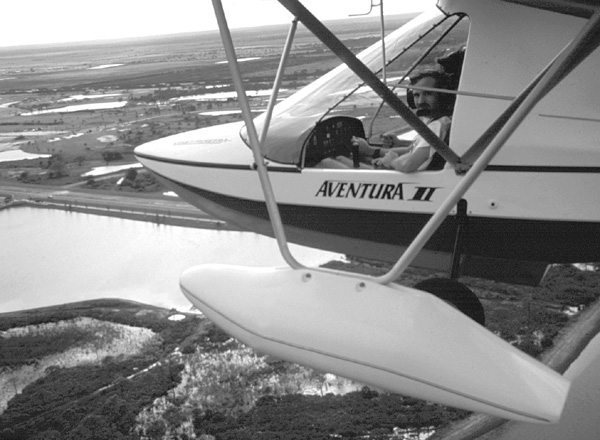
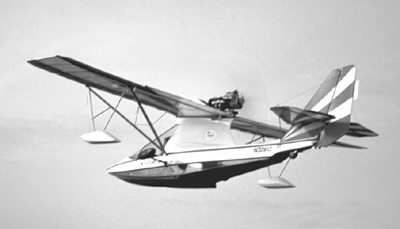
UP & AWAY – With gear retracted, this pretty Aventura II is seen climbing away from a water launch out of a lake nearby Arnet Pereyra’s Florida factory.
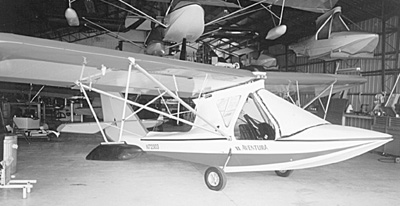
BACKGROUND SHOT – The newly completed Aventura II in the foreground is pretty but the background tells a story. If you look closely, you’ll see several kits ready to ship.
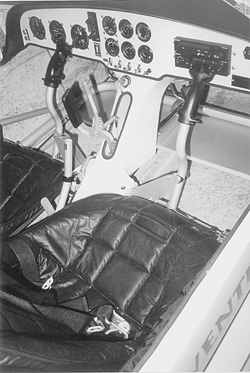
GEARED UP – If this isn’t enough bells and whistles for you, you’ll have to investigate an F-16 or something. This buyer wanted the works and it appears he got them.
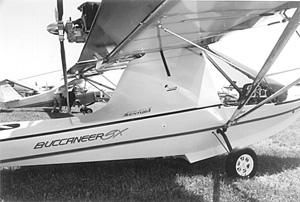
REPLACEMENT HULLS – Arnet Pereyra now also manufactures the Highcraft Aero-Marine Buccaneer line of ultralights under an agreement with Highcraft owner John Gruener. Owners of these models will be pleased to hear that Arnet’s new Aventura hull fits well on the older Buccaneers.

CRITICAL FUNCTION – Some of the many components Carlos Pereyra got right include the seals between the hull and retractable main gear. Nonetheless, a bilge pump is standard equipment.

VERTICALLY EQUIPPED – Prominent in both appearance and in the standard equipment list is this brand new BRS-1200 parachute in the new Vertical Launch System configuration. Arnet Pereyra provides this as part of the base price.

FLYING COP – Florida’s Volusia County sheriff’s department liked the Aventura II so much they now utilize one in law enforcement and search-and-rescue efforts.

BUILDING GUIDES – Many of the aluminum parts employ these reference examples which are carefully labeled as part of the company’s quality process.

GO JUICE – With a 12-gallon fuel system, the Aventura II has some range. With the optional cargo deck over this structure, you can carry baggage with you (assuming your weight and balance check is careful).

PARTS APLENTY – With adequate financial backing, Arnet Pereyra can ship kits from stock. Here you see a large storehouse of components all ready for crating.
If you’ve never flown an airplane on floats, you’ve missed a glorious experience in flying. Good as any ultralight on floats may be – and that means “quite excellent” in my opinion – even those pilots with that experience may have missed the unique sensation of a boat-hulled ultralight.
With a few thousand hours in my logbook covering everything from foot-launched hang gliders to twin-engined Barons, I can honestly say my absolute favorite hours are spent in one of two ways: first is soaring flight, but a close second is warm summer day flying in an ultralight floatplane.
It just doesn’t get any better.
Having stuck my personal opinion into this article, I must tell you about a most promising company and their 2-seat floatplane, the Aventura II. Since Arnet Pereyra exploded into the ultralight scene in 1995, this new company has filled out their line of floatplanes with a roomy and fun 2-seater which deserves a close look.
New From Arnet Pereyra
Both their single- and 2-seat Aventura models bear a striking resemblance to Highcraft Aero-Marine’s Buccaneer ultralight amphibian. The Buc’, as it was affectionately known, won a strong following and for years was the only boat-hulled amphibious entry among ultralights.
The similarity of the Aventura models to the Buc’ is no surprise as several key employees of Arnet Pereyra have backgrounds at two former ultralight manufacturers that used to manufacture the Buc’ – Advanced Aviation and Keuthan Aviation.
So, who is Arnet Pereyra anyway?
Sunglasses impresario-turned-aviation-financier Greg Arnet is one of the company’s four principals. Carlos Pereyra is another and it is their names which come together at the central Florida manufacturing company.
A South American expatriate, Pereyra is the main designer behind the new offering. Pereyra is held in high regard for both his design abilities and his concern for building quality equipment. Several family members work with him in Arnet Pereyra and their skills seem to complement his in a very useful way.
Two other key players bear mention. Though he’s now left the firm to build Aventuras (and other aircraft) for customers, former “front man” Steve Darrow was a key figure along with Craig Lark, the last of a quartet that gave birth to the new Arnet Pereyra company.
Adequate capital is apparently available to Arnet Pereyra. Two backers funded the new company well enough that it is now housed in brand new quarters and can put kits on the shelves for quick delivery. In the bumpy world of ultralight aviation, immediate kit availability can be rare. This suggests Arnet Pereyra will continue to be a player for some time.
Whenever you can combine good financial resources with talented designers and quality employees, the result should be dandy aircraft. As we take a more intimate look at the Aventura II, you might end up considering purchasing this floatplane.
Close-Up View
Let’s go fly! I’ll bet you’ll become infused with my excitement.
Entry begins as you sit on the hull side rails and swing your legs into position. A structural tube supports you as you put full weight on the lip of the hull. Certainly, this is no more gymnastic than entry to most ultralights I’ve entered, and it’s better than many.
You must swing your legs into position but with the 2-seater’s broad cabin, leaning a bit into the opposite seat makes this somewhat easier.
Once seated on the well-padded seat, and before my co-pilot Steve Darrow joined me, the cockpit felt extremely wide. The 2-seat Aventura is like sitting on your living room sofa.
The rudder pedals were aimed back at me with a fairly raked angle. Nonetheless they were comfortable with outstretched legs as mine were. An aluminum floor pan near the pedals supported my heels without putting unnecessary pressure on the hull.
I entered the Aventura on land at the Arnet Pereyra factory. I never did a water entry/exit, but expect that the lower position of the Aventura relative to the water and probable need to step up to a dock would present more physical challenge.
Engine startup was simple with no tug of war with a pull handle. A twist of the electric start key switch cranked up the 66-horse Rotax 582 engine. Ground steering proved good as I taxied to the far end of the field for takeoff.
The Arnet Pereyra airport is an older facility which probably once sat by itself with open areas all around. That isn’t the case today. The airport is hemmed in rather tightly with developments and forested area. To the west, the strip is open but on the other three sides, you have little recourse for an emergency landing should a problem arise.
None did. However, I was more than content to let Darrow handle the takeoff chores for this first departure. All went well and we were soon headed to an enormous open area of fresh water to the northwest of the factory airport.
On this large body, I was able to execute numerous water landings and takeoffs, and afforded that joyful opportunity to fly so low over the surface that the hull occasionally skipped the lightly wind-whipped lake.
Pereyra has done his homework on boat hulls with help from Aero Comp, an experienced float builder located on a neighboring field. The Aventura hulls work so well that the company began selling replacements to former Buccaneer owners.
After a few skips and goes, I allowed the bird to slow to a halt in the water. Though she sits rather low in the water, she was highly stable and felt comfortable. In rough conditions, you’d surely take on a little water, but you don’t have to land on rough water (unless you’re ditching). After all, an amphibian can be taken to land as easily as water, assuming you’ve got power.
Following a quick stop, the 2-place Aventura’s next test was slow water taxi steering. In the huge lake, I could do what I wished and so made a series of 90° turns to see how responsive she was. Steering in water proved adequate, though the single-seat Aventura is understandably more agile.
Downwind taxiing in a floatplane is a unique experience if any amount of wind is blowing. In short, floatplanes always want to orient into the wind. Only prop blast over the tail and continued movement keeps you headed downwind. The Aventura II worked quite well, possibly because the beefy engine gives lots of air movement without overworking the powerplant.
Boating around is fun but flying is better. It was time to let the bird have her head. In moments, she pointed into the wind. After a close look for floating debris – one sure way to spoil the takeoff event – and assuring adequate distance before any obstacles, I goosed the throttle and we started moving briskly.
The Aventura with its potent liquid-cooled Rotax 582 climbs authoritatively, even with a relatively short wingspan (28 feet) on the model I flew for this report. The factory now offers a longer wing (30 feet 8 inches), which will do several good things for a modest expense of additional weight: Her takeoff run is shortened to perhaps 200 feet (it’s really hard to measure this on water), she’ll climb faster and start doing so sooner, and the stall speed is lowered.
I simply cannot overemphasize the pure fun of flying this plane. True of other floatplanes as well, water-based flying in warm climates has a special quality that is hard to duplicate. As Darrow and I glided by many lovely homes built at the water’s edge, I renewed my fascination for this kind of flight. For a Minnesota boy like me, it can bring meaning to all those 10,000 lakes for which that state is famous.
But this was warm Florida. Talk about enjoying ourselves! The air was pleasantly warm, neither of us was getting buffeted by wind blast, and protection was excellent from the large windscreen.
Adding more throttle after a mini-tour of the local homesites, we rose swiftly to altitudes where I could explore more Aventura potentials.
Aventura With Altitude
Handling rates good marks for a 2-seater. The company’s single-place machine is far more able to dart around the sky. In comparison, the Aventura II lumbers a bit. Since this one probably weighs more than the average, I must admit the handling is better than average.
The control forces are reasonably light, and control harmony was very good. I felt roll was a little better to the right, but then, this is typical of pusher ultralights.
Dutch rolls (coordination maneuvers which bank about the longitudinal axis) went well to moderate angles. I was able to perform dutch rolls satisfactorily on this first flight, providing a positive impression.
Steep turns in the Aventura II revealed good stick range in pitch. A little extra rpm kept altitude about where I began, one measuring stick of turn efficiency.
Investigating basic stability, I discovered full-power stalls were uneventful. Always a positive attribute, the Aventura II’s nose never dropped through. Idle thrust stalls showed only the very mildest of breaks and I found no wing dropped regardless of direction.
The central Florida lake scenery once again captivated my attention. Fortunately, the Aventura II has great forward visibility and on my left side I could look behind me easily, checking the tailplane. However, I couldn’t lean far enough to check the tailwheel position.
While I was twisting about in my seat, I recalled an earlier Aventura complaint: the amphibs come standard only with lap belts. I much prefer 4-point harnesses though some seaplane pilots say you must be able to escape quickly in the event of water ditching (assuming a loss of flotation). This may be valid, but at least you should take the company up on optional shoulder belts. (In keeping with that seaplane operation philosophy, I guess, Arnet Pereyra’s land plane model comes standard with shoulder belts.)
Cycling the landing gear lever up and down while airborne showed it to be superior to the older Buccaneer version. That’s good! Without practice, I was unable to perform this vital function in the Buccaneer II. I realize technique will permit it but if you don’t have the knack, you may not accomplish it at all. The Aventura II retract mechanism benefits from a linkage with lower friction and gives a good tactile feel for locking into position. Nonetheless, get some tips on doing it before you have to; and then practice it repeatedly until you’re comfortable.
Fortunately, while airborne the gear will literally fall into the down and locked position thanks to a simple overcenter arrangement. In the water you must reach down and push the mains to a locked feel before you drive the amphibian up on the beach.
It seems unnecessary to say it but when landing on water, make sure the gear is up. Landing in water is a fascinating experience when you don’t do it regularly. Yet you’ll want to skip the experience of landing gear down in water as it is entirely possible to swamp the aircraft.
Conversely, landing gear up on land is much less fearsome. In fact, a gear-up technique can be useful if landing in an emergency. A skidding stop may be far preferable to wheels which can’t handle rough terrain and threaten to flip the plane. On wet grass the landing may not seem much different than a water landing, except you’ll get no water cushion.
In the Aventura II, I used the common technique of setting up a landable attitude and holding it right onto the water. Such a method is very useful on glassy-smooth water where your depth perception is deceived.
A potentially enormous benefit is that you can nearly always land directly into the wind on water – and the wind lines on the water give you plenty of reference in strong enough breezes
As with the single-place model I flew earlier, I was able to execute flare landings by employing the same technique one does on land. If your technique is good enough, you can save the hull from unneeded abuse while slowing more quickly
When I hit the throttle, the Aventura II smoothly came off the water like the water fowl she is. Ah, such a sweet feeling.
Loaded For Fun
Seaplanes or floatplanes aren’t your cheapest aviation toy, although compared to any certified floatplane, the Aventura II represents pocket change.
Admittedly, your pockets will have to be reinforced to carry that much change but then, look at all the standard stuff that comes with the Aventura II. (Contact the factory for any changes before you make a purchase).
You’ll get all the beautifully formed fiberglass parts – and these guys are good at fiberglass work; it is some of the best you’ll find in aviation. You also get the sewn Dacron wings, tail, and “body sock.” This will save you many hours of dope and fabric work plus it will save many pounds of paint and finishers.
You get streamlined struts, the retractable gear system which includes the steerable tailwheel, and wide aluminum wheels. A radiator cowling is standard as is fixed rudder trim and adjustable elevator trim. The tail can quickly fold.
Aventura II’s standard engine is the Rotax 582 with dual CDI and “B” gearbox. The bird also includes prop, instruments, instructions, and a key safety element, a standard ballistic parachute (worth more than $3,000 all by itself).
All this will cost you $22,900 and at such a price, I feel the Aventura II is an excellent buy. If you use the Ultralight Flying! Buyer’s Guide and add to other 2-seat ultralights options like an amphibious float system, ballistic parachute and the other standard goodies, I believe you’ll find a lot of 2-seat ultralights can easily run upwards of the $23,000 price tag of the Aventura II. In addition, the Arnet Pereyra seabird is a package deal, all put together the right way. On other aircraft, you become something of a designer to cobble together all the right parts.
I have to tell you one more thing. I work next to Wipaire, one of the largest float builders in the world. Amphib floats alone for a general aviation aircraft are priced thousands of dollars more than the entire Aventura II aircraft kit.
Naturally, if you are determined to spend lots more on your personal Aventura II, Arnet Pereyra has a long list of options.
My check pilot, Steve Darrow – now an independent entrepreneur building Aventuras for customers – estimates the average build time from kit to be about 200 hours, though this obviously varies widely from builder to builder. Yet the Aventura II is a bolt-together kit that shouldn’t be too tough, though you may want advice about things like skinning tightly-fit ailerons.
My impression from following the Arnet Pereyra company for a couple years and after visiting the factory is that this company is well-financed and as well-grounded as any ultralight producer.
One thing I can be pretty confident in saying: Fly the Aventura II; you’ll like it. Having now flown both single- and 2-seat models from Arnet Pereyra, I think these planes provide the chance to enjoy some of the best type of flying life offers.
| Seating | 2-seater |
| Empty weight | 640 lbs |
| Gross weight | 1,150 lbs |
| Wingspan | 30 feet 8 inches |
| Wing area | 161.7 square feet |
| Wing loading | 7.11 pounds/square feet |
| Length | 23 feet |
| Height | 7 feet |
| Fuel Capacity | 12 gallons |
| Kit type | Assembly |
| Build time | 200 hours |
| Standard engine | Rotax 582 |
| Power | 66 horsepower |
| Power loading | 17.42 pounds/hp |
| Cruise speed | 70 mph |
| Stall Speed (Flaps) | 32 mph |
| Stall Speed | 45 mph |
| Never exceed speed | 90 mph |
| Rate of climb at gross | 500 fpm |
| Takeoff distance at gross | 200 feet |
| Standard Features | Fiberglass hull/upper deck/ body sock, reinforced tubular construction, streamline struts, landing gear retract system, steerable tail wheel, 8-inch aluminum wheels, brakes, ballistic parachute, streamline radiator cowling, 12-gallon fuel tank, clear Lexan windshield, fixed rudder trim, elevator trim tab, double surface wings, quick folding tail, 2-color fabric, foam seat, ignition switches, airspeed indicator, altimeter, hourmeter, tachometer, EGT, water temperature gauge, compass, electric flaps, bilge pump.
Spanish and English spoken. |
Design
Cosmetic appearance, structural integrity, achievement of design goals, effectiveness of aerodynamics, ergonomics.
Pros – Design may look familiar (like a Buccaneer II), but it’s a new plane from a new company. Roomy and capable; a lot of good can be said about this new but proven plane. Familiar construction to ultralighters. Beautiful hull work. All fiberglass is superb. Works very well as amphibious model. Excellent capacity for occupants and some luggage.
Cons – Ultralights adapted to floats may be considerably lighter; heavier planes like Aventura II need to be flown more attentively to speed and space requirements. Company establishing good reputation but a limited number of aircraft are flying at this t
Systems
Subsystems available to pilot such as: Flaps; Fuel sources; Electric start; In-air restart; Brakes; Engine controls; Navigations; Radio; (items covered may be optional).
Pros – Many goodies are standard: electric flaps, retractable gear, trim, bilge pump, a good complement of gauges, and a ballistic parachute are part of the price. Electric starting was nice on the test plane.
Cons – When you have a lot of systems, you must learn to manage them; this will take more time and not spending it may cost you. Look at the cockpit photo – you’ll see lots of levers and controls.
Cockpit/Cabin
Instrumentation; Ergonomics of controls; Creature comforts; (items covered may be optional).
Pros – Big boys won’t be squeezed together. Even some cargo can be carried if occupants weigh less than 215 pounds each. Entry is reasonable by first resting on side rail. Reach to panel and all controls is excellent. Seats are very comfortable. Windscreen protection is excellent.
Cons – Many seaplanes advise only lap belts to allow escape if upset in water; personally I prefer the optional shoulder belts. Seats don’t adjust. No other negatives.
Ground Handling
Taxi visibility; Steering; Turn radius; Shock absorption; Stance/Stability; Braking.
Pros – On ground or in water, steering is very reasonable thanks to steerable tailwheel and rudder. A wide, low posture makes the Aventura II very stable on the ground, and in the water it might just be even better. Good forward visibility and some upward visibility to the side allows adequate traffic checks.
Cons – While steering is good, turn radius is wider than average – plan ahead. This bird is heavy, you must also plan your stopping. Ground clearance is slight. Downwind taxiing in a seaplane takes practice.
Takeoff/Landing
Qualities; Efficiency; Ease; Comparative values.
Pros – Basic takeoff and landing operations are straightforward. Short water runs attest to a good hull design. Flaps will help steepen your approach path. Slips are easily achieved. Though you may never plan an off-field gear up landing, a boat hull can be safer than gear on rough fields (though damage may result).
Cons – A heavier bird like this demands more attention to speed and space requirements. In an amphib with retractable gear, you must remember what surface you’ll use for landing – and put the gear in the appropriate position. Remember, “there are only two kinds of pilots|”
Control
Quality and quantity for: Coordination; Authority; Pressures; Response; and Coupling.
Pros – Very good control response among 2-seaters; even “good” when compared to more agile single-seaters. Very good control harmony makes for quick transitions from other aircraft. Crosswind capabilities are excellent (though you shouldn’t need them on larger lake landings). Steep turns went well with good stick and rudder range remaining.
Cons – Roll rate isn’t fast (like a lot of 2-seaters). Retracting gear definitely requires acquiring some good technique and then practice. Adverse yaw is clearly present. No other negatives.
Performance
Climb; Glide; Sink; Cruise/stall/max speeds; Endurance; Range; Maneuverability.
Pros – Amphibs aren’t noted for their blazing speeds, though boat-hulled ones do quite well (e.g., 70 mph cruise). Climb is certainly adequate given the weight of this seabird (about 500 fpm with a Rotax 582). Low flying over the water is excellent, simply superb – partly because hull works so well should you touch down inadvertently. Docking is simple with the high wings and stable water operations.
Cons – Endurance is lower, range is less with a Rotax 582; 12 gallons will last little more than a couple hours depending on operation. You’re pushing a lot of plane through the air, so more power is required to hold altitude.
Stability
Stall recovery and characteristics; Dampening; Spiral stability; Adverse yaw qualities.
Pros – Stalls, whether power-on or -off, went very well. No wing drop tendency noted. Accelerated stalls merely went to mush mode. Longitudinal stability was normal and dampened quickly within three oscillations. Power response was neutral to positive (acceptable for high wing pusher engine mount).
Cons – Some adverse yaw must be anticipated. No other negatives discovered.
Overall
Addresses the questions: “Will a buyer get what he/she expects to buy, and did the designer/builder achieve the chosen goal?”
Pros – You can get one! | meaning kits are in stock. Factory workmanship appears excellent; stems from an attitude to give a buyer good value. A base price of $22,900 includes a standard ballistic parachute. This plane can deliver most of the fun of flying an ultralight floatplane. Factory has earned good owner remarks for technical support.
Cons – A license and FAA inspection are required. Relatively new company, though no complaints have been directed my way.


Considering the Aventura airframe has roots in the Buccaneer, can components of the Buccaneer II be repaired/upgraded with current Aventura II parts?
Possibly yes, but please contact Aero Adventure for the best info.
Nice Hydro. where to see and buy please. Send address.
Thanks.
Contact Aero Adventure.
Still available?
Did you not see this article with video?
Dan, did you ever write a review of the single seat you flew?
Thanks again
Greg: I did, but that was so long ago that we did not attempt to go back and digitize those pre-Internet articles.
This is a very nice article Dan
I am very interested in this airplane
I am a private pilot with a seaplane endorsement but it has been a while since I’ve flown
Will I need a current class 3 medical to fly this aircraft
Thank You for all you do !!!
Curt: Thanks for your kind words; appreciated. You do not need a Class 3 Medical to fly Aventura as it meets parameters of a Light-Sport Aircraft (weight, speed, etc.). At present it is only available as an Experimental Amateur Built kit — that still qualifies for not needing a medical — but a Special LSA version has completed all the work and is only waiting for FAA to come visit and accept the design. Then you can buy a full-built Aventura if that is of interest.
Do you need to have a private pilot’s license with a with a sea endorsement to fly the Aventura II? Can I log the time flown on the Aventura II in the logbook as with any other plane, or it doesn’t apply because it is such a small airplane?
HI Ismar: Aventura II is an Experimental Amateur Built …for now, but stay tuned. As such, any insurance company is sure to require at least training in seaplanes if not an official rating. All time acquired in such an aircraft (EAB or LSA, if one comes) does count toward other certificates.
I’m wondering if you need a private pilot’s license with a water endorsement to operate this airplane. If you do, can Flights in the Aventura II be logged in the logbook as any other GA aircraft?
Hi again Ismar: Please see my other response. I regret a delay getting back to you.
Hello! Excellent article. I first met Steve Darrow in Merrit Island during the mid-90’s and did a lot of air-to-air photography with him as model/pilot.
If there is any updated info on his current location and endeavours, please contact me.
David Cate
Titusville, FL
DavidCate@live.com
321-305-1651
Hi David: I don’t know the whereabouts of Steve but the good folks at Aero Adventures might. I urge you to contact them (see their banner int the right column or use search).